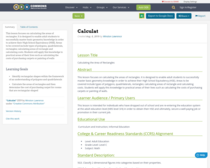Description
- Overview:
- This lesson focuses on calculating the areas of rectangles. It is designed to enable adult students to successfully master basic geometry knowledge in order to achieve their High School Equivalency (HSE). Areas to be covered include types of polygons, quadrilaterals, rectangles; calculating areas of rectangle and calculating costs. Students will apply this knowledge to practical areas of their lives such as calculating the costs of purchasing carpets or painting of walls
- Remix of:
- Calculating the Areas of Rectangles
- Subject:
- Mathematics
- Level:
- Adult Education
- Material Type:
- Interactive, Lesson Plan
- Author:
- Winston Lawrence
- Date Added:
- 05/15/2016
- License:
-
Creative Commons Attribution

- Language:
- English
- Media Format:
- Downloadable docs, Graphics/Photos, Text/HTML


on May 24, 10:38pm Evaluation
Quality of Explanation of the Subject Matter: Limited (1)
While a great start, the lesson ought to include more background information about the key terms. For example, include definitions for each term and the relationship between them. Second, write out the steps to solving the sample problems. Third, write out perimeter equations for the shapes you mentioned. A teacher w/ a non-math background should be able to teach this w/o wondering about the meanings of polygon and quadrilateral.
on May 24, 10:38pm Evaluation
Utility of Materials Designed to Support Teaching: Strong (2)
The lesson does include one suggestion for ways to use materials with an advanced learner, but I'd suggest including at least 2 math problems each for low, mid,and high level learners. Also, supply opportunities for learners to work backwards by deconstructing a concept. For example, provide an area of a rectangle and ask students to draw as many rectangles or polygons/quadrilateral as possible.
on May 24, 10:38pm Evaluation
Quality of Instructional and Practice Exercises: Strong (2)
Each exercise can include a few more examples and/or explanations. Also, perhaps require written explanations/proofs from students. The original EngageNY lesson has detailed examples you can use to model your inquiry.
on May 24, 10:38pm Evaluation
Opportunities for Deeper Learning: Strong (2)
Do ask students to 'construct viable arguments and critique the reasoning of others.' Also, provide another example of a real-world situation, perhaps, or a hands-on activity.